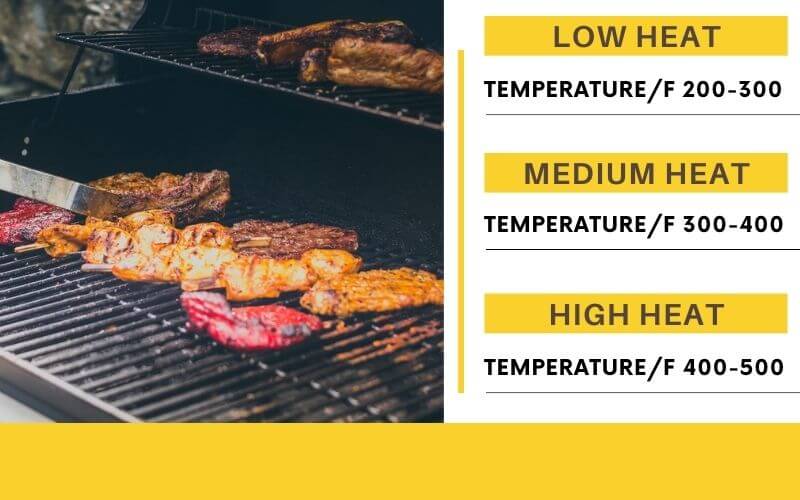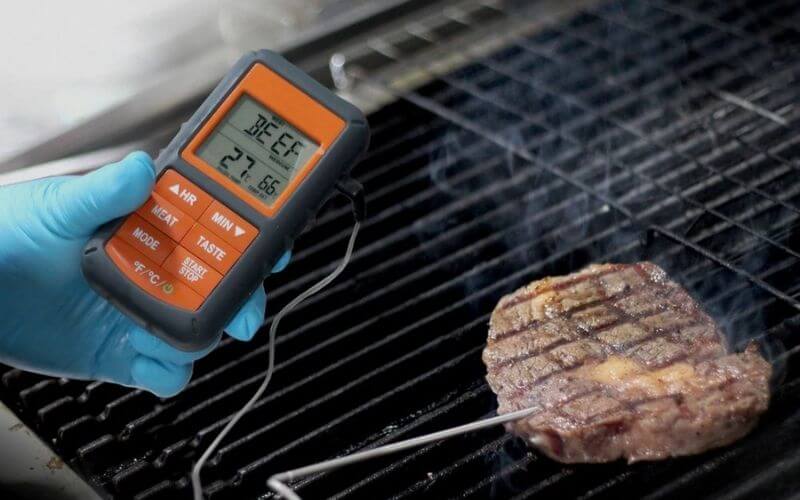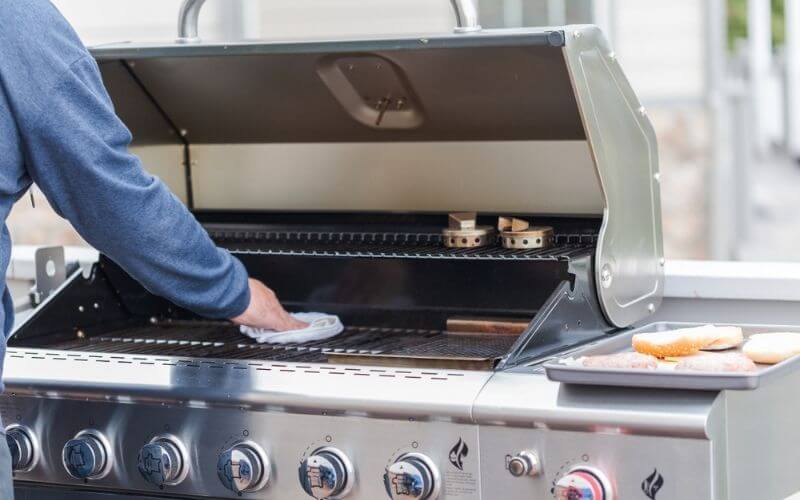Mastering medium heat is key to grilling like a pro. This range, 350 to 450 degrees Fahrenheit, gives steaks a perfect sear and cooks veggies just right.
Medium heat ensures well-cooked food, boosting your confidence to try any recipe. So, 🔥 fire up the grill and get ready to impress with your newfound grilling savvy! 🍔🌟
Grill Temperature Cheat Sheet

Discovering the sweet spot for grill temperatures can transform a good meal into a great one. Take grill temp seriously, like an artist would with colors. Imagine a scenario where a single degree can decide if a steak is succulent or just satisfactory.
Grill Temperature Ranges:
- Low Heat: 200-300°F – Ideal for slow-cooking meats like ribs.
- Medium Heat: 300-400°F – Perfect for a wide range of foods, including vegetables and burgers.
- High Heat: 400-500°F – For quick searing and those distinctive grill marks on steaks.
Here’s a quick reference table for grilling temps in Fahrenheit:
| Heat Level | Temperature Range |
|---|---|
| Low | 200-300°F |
| Medium | 300-400°F |
| High | 400-500°F |
Once, a stubborn cut of beef taught me the subtle art of temperature control. It’s a skill that turns good cooks into great grill masters.
🔥 Tip: The difference between medium and medium-high could be pivotal for texture.
Grasp these nuances, and the grill becomes an ally in your culinary adventures. No chart replaces the intuition gained from hands-on experience with cooking temperatures.
What is Medium Heat on a Grill?

When it comes to grilling, working with exact temperatures is essential for the best results. Certain temperatures are optimal for slow cooking, while others are better for a quick sear. If you have an old-fashioned grill, you might see settings labeled from low to high. Here’s what these terms mean in terms of temperature:
Low Heat
For those wondering, “What temp is low” or “What temp is low heat” on a grill, think of it as the zen zone. This is where you cook ribs so tender, they fall off the bone. On my grill, low heat means keeping the temperature steady at around 200-250 degrees Fahrenheit. It’s the secret to my famous slow-cooked barbecue sauce that friends still ask about.
Medium-Low Heat
The range of 325 to 350 degrees Fahrenheit is your medium-low playground. It’s perfect for items that need a gentle touch, like a delicate fish that the USDA recommends cooking thoroughly without drying out. Remember, patience is key here – it’s about the slow melding of flavors, not a race to the finish line.
Medium Heat
“What temp is medium heat on a grill?” As a rule of thumb, medium heat ranges between 350 and 375 degrees Fahrenheit. It’s the ideal grill temperature range for creating those perfect grill marks on a steak, without overcooking the interior. Think of it as the balancing act of grilling – hot enough to sear, yet cool enough to cook through.
Medium-High Heat
When I think of medium-high heat, which is between 350 and 375 degrees Fahrenheit, I recall the thrill of grilling at a bustling New York rooftop party, where quick, high-heat cooking was essential. This range, where what temp is medium-high heat on a grill really shines, is ideal for those sizzling kebabs and veggies that need to cook through quickly yet remain juicy.
High Heat
The searing intensity of high heat, typically above 450 degrees Fahrenheit, is where the magic happens for a quick-sear crust. The key is not to overdo it – a lesson I learned while experimenting with different meats and marinades.
Expert Insights on Medium Heat Grilling

Grilling is an art where mastering medium heat is essential. Infrared thermometers help us measure the heat accurately, creating ideal grilling zones. Indirect heat grilling is a technique I perfected by observing and experimenting with different types of meat and their cooking times.
- Infrared thermometers: Use these tools to measure grill temperature accurately.
- Grilling zones: Define areas on your grill for different cooking needs.
A two-zone grilling setup offers both high and moderate heat areas on the grill. The constant adjustment of optimal grilling temperatures is key, much like steering a ship to keep it on course.
- Two-zone grilling setup: Combines high and moderate heat areas for versatility.
- Optimal grilling temperatures: Adjust these like steering a ship for precise cooking.
For added flavor, I set up a grill for smoking with soaked wood chips. It’s also vital to clean and maintain grilling equipment for consistent results.
- Setting up a grill for smoking: Adds smoky flavors with wood chips.
- Cleaning and maintaining grilling equipment: Essential for consistent grilling performance.
I use the grill’s hotter areas for a quick sear when needed. Remember, whether it’s indirect grilling or direct heat, perfect grilling is an ongoing journey.
- Quick sear: Utilize hotter areas of the grill for a quick sear on meats.
- Grilling journey: Continuously learn and adjust your methods for perfect results.
Grilling Techniques:
| Technique | Description | Tips |
|---|---|---|
| Indirect heat grilling | Circulates heat around the food, not directly over flames. | Ideal for larger cuts or whole birds. |
| Two-zone grilling setup | High and moderate heat areas on the grill. | Use high heat for searing, moderate for cooking through. |
| Setting up a grill for smoking | Enhances flavor with wood chips. | Use soaked chips for best results. |
Checking Your Grill’s Temperature

Grasping the medium heat concept on the grill isn’t just about numbers; it’s an art. Picture this: a steak sizzling over the grates, the aroma hinting at perfection. To ensure it’s on point, a high-quality food thermometer is your best ally. This isn’t just guesswork; it’s the key to unlocking flavors that linger on the palate. Think of the thermometer as a secret weapon, one that consistently delivers just-right results.
| Temperature Range | Grilling Method | Tips & Tricks |
|---|---|---|
| Low Heat (225-250F) | Slow-cooking, smoking | – Ideal for tougher cuts of meat. – Use a high-quality food thermometer to ensure meat reaches the desired internal temperature. |
| Medium Heat (325-375F) | Direct grilling | – Perfect for whole chickens or roasts. – Test heat by holding your hand about 6″ from the grate; 4-5 seconds is ideal for medium. |
| Medium-High Heat (375-450F) | High-temperature grilling | – Suitable for burgers and fish fillets. – Use a point-and-shoot thermometer for quick surface temperature checks. |
| High Heat (450F+) | Quick searing | – Best for thin cuts or quick cook times. – Preheat the grill grate for a perfect sear. |
To check if the grill is at medium heat, place your hand roughly 6 inches above the grate. Count the seconds you can hold it there comfortably.
Four to five seconds? That’s your sweet spot for medium. It’s a trick as old as grilling itself, a direct connection to the heat that modern gadgets like a point-and-shoot thermometer simply can’t replicate.
Now, imagine laying down that marinated piece of chicken. With the grate at medium heat, it cooks evenly, browning beautifully without a charred exterior. Direct grilling at this temperature isn’t just efficient; it’s a dance between fire and food. A grill grate is the stage, and each meal is a performance, its success measured by the applause of flavors erupting with each bite
Recipes for Medium Heat Grilling
| Food Type | Grilling Tips |
|---|---|
| Steak | Sear for 4-5 minutes each side for medium-rare. |
| Fish | Cook until it flakes easily but is still moist. |
| Tuna Steak | Char the outside, keep the inside pink. |
| Shrimp | Grill until pink, about 2-3 minutes per side. |
| Hamburgers | Medium heat until cooked through, juicy but not dry. |
| Chicken Drumsticks | Turn frequently, cook until juices run clear. |
| Chicken Thighs | Medium heat until skin is crisp and meat is cooked. |
Starting with medium heat grilling offers many delicious possibilities. The direct grilling method at this temperature is perfect for many dishes.
The heat is enough to sear the steak well, keeping it juicy and tender.
Keep in mind, the steak’s thickness sets the grilling time; usually, 4-5 minutes each side for medium-rare.
Fish, which can overcook easily, cooks well at medium heat. For tuna, the grill temp for tuna steak should char the outside but keep the inside pink and flavorful.
For grill temp for hamburgers, medium heat cooks the patty well without drying it, which is key for a great burger.
Grill Safety and Medium Heat

- Always grill within the medium heat range to minimize the risk of forming harmful HCAs and PAHs.
- Achieve an internal temperature that’s recommended for each type of meat to ensure safety against bacteria like E. coli.
- Use a digital thermometer to check the doneness of your meats accurately.
- Preheat the grill properly to reach the ideal cooking temperature before adding your food.
Recommended Temperatures for Safe Grilling:
| Meat Type | Ideal Internal Temperature | Recommended Grill Temperature Range |
|---|---|---|
| Ground Beef | 160°F to prevent E. coli | Medium heat to reduce harmful chemicals |
| Steak | 145°F for a perfect medium-rare | Medium heat for the best balance of safety and flavor |
| Chicken | 165°F to kill bacteria | Medium heat, check frequently to ensure thorough cooking |
Key Facts:
- According to the American Cancer Society, cooking meat at high temperatures can produce carcinogenic chemicals like HCAs and PAHs.
- Grilling at the right temperature is crucial; for instance, E. coli is killed at 160°F, which is the internal temperature for ground beef.
Adjusting the Heat of Your Grill
Mastering medium heat on your grill can transform your outdoor cooking from good to great. It’s the key to a successful grill session, where the aroma of perfectly grilled food fills the air. Here’s how to adjust your grill for medium heat, which is essential not just for taste but for safe cooking too.
First, it’s about managing the oxygen flow. With charcoal grills, it’s the dance of the vents. Opening the bottom vent while adjusting the top creates a controlled flow that keeps the heat just right. This careful balance prevents the prolonged direct grill heat that might char your food instead of cooking it evenly.
For gas grills, the knobs are your best friends. They directly adjust the flame, giving you a responsive tool to maintain the temperature at grate level. This is where your trusty grill thermometer becomes indispensable. Aim for 350-375°F to hit that medium heat sweet spot.
Remember, direct grilling isn’t just about the thrill of the flames; it’s a method that, when done correctly, results in juicy, flavor-packed meals every time. Plus, it’s a safer way to cook, ensuring meats reach temperatures that keep foodborne illnesses at bay.
So, next time you’re at the grill, think of the vents or knobs as instruments in an orchestra. You’re the conductor, making sure each note hits perfectly to create a symphony of flavors.
Understanding Grill Materials and Medium Heat
When aiming for the perfect grilled meal, your grill grate material is crucial. Here’s how different materials compare:
| Grill Material | Heat Retention | Responsiveness | Best Used For |
|---|---|---|---|
| Cast Iron | Excellent | Lower | Indirect grilling, medium heat for large dense vegetables or meats |
| Stainless Steel | Good | High | Quick temperature changes, replenishing charcoal during grilling |
Cast iron grates are known for their superior heat retention, ideal for maintaining medium heat using the indirect grilling method. Stainless steel grates might not hold heat as well, but they adjust quickly to changes in temperature.
Your choice of fuel, whether charcoal or wood chunks, affects the grill’s ability to keep medium heat. A chimney starter ensures an even temperature from the beginning, which is essential for a consistent cook.
These material characteristics are not always noticeable, but they are vital for successful grilling. Every component, from the grate to the fuel, plays a part in your culinary performance, directly influencing the delicious results of each grill session.
FAQs
01. What Temperature is Medium Heat on a Gas Grill?
Medium heat on a gas grill is around 325F to 375F or 162C to 190C.
02. How Many Degrees is Medium High Heat?
The temperature range of 375 to 450F or 190C to 232C is considered to be of medium-high heat.
03. How Long Should I Preheat My Grill?
A good rule of thumb for preheating the grill is to do it for 15 minutes, as this brings the grill up to your desired temperature. You may have to add more charcoal or adjust the vents later.
04. How Do I Control the Heat on a Charcoal Grill?
The heat level on a charcoal grill can be controlled by adjusting the vents on the top and bottom of the grill.
05. How Will I Know when the Charcoal Briquettes are Ready?
Once most of the charcoals have burnt though, turned white, and stopped smoking, your charcoals are hot enough to start grilling.
To Wrap Up
To sum up, knowing medium heat on the grill is key for great grilling results. This crucial range, 350 to 450 degrees Fahrenheit, means well-seared steaks and nicely charred veggies without burning 🔥.
The article covered grill temperature details, gave tips for steady medium heat, and stressed safety to avoid chemicals 🚫.
Whether you’re a seasoned grill master or a novice, mastering medium heat is an essential step towards grilling perfection. 🍖👨🍳